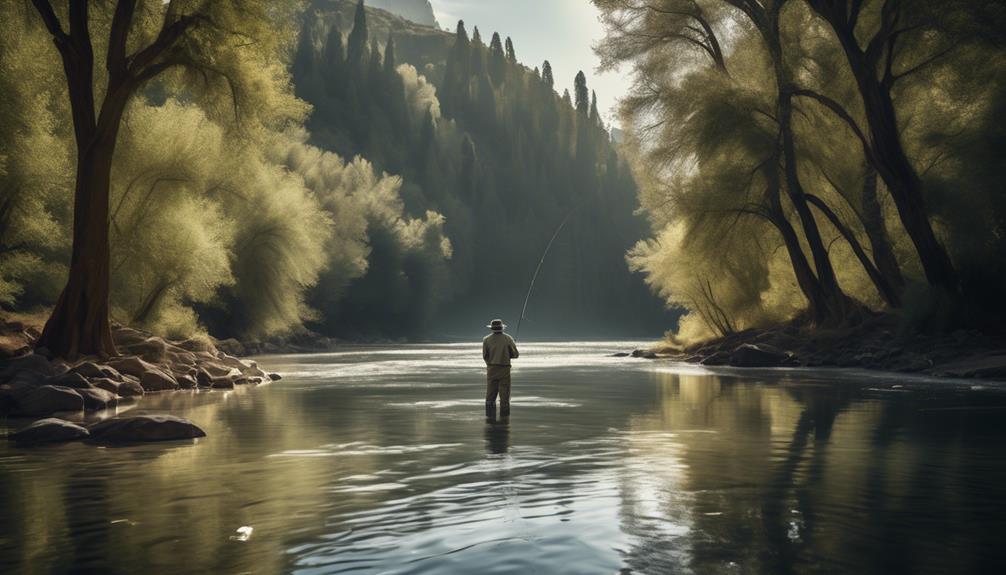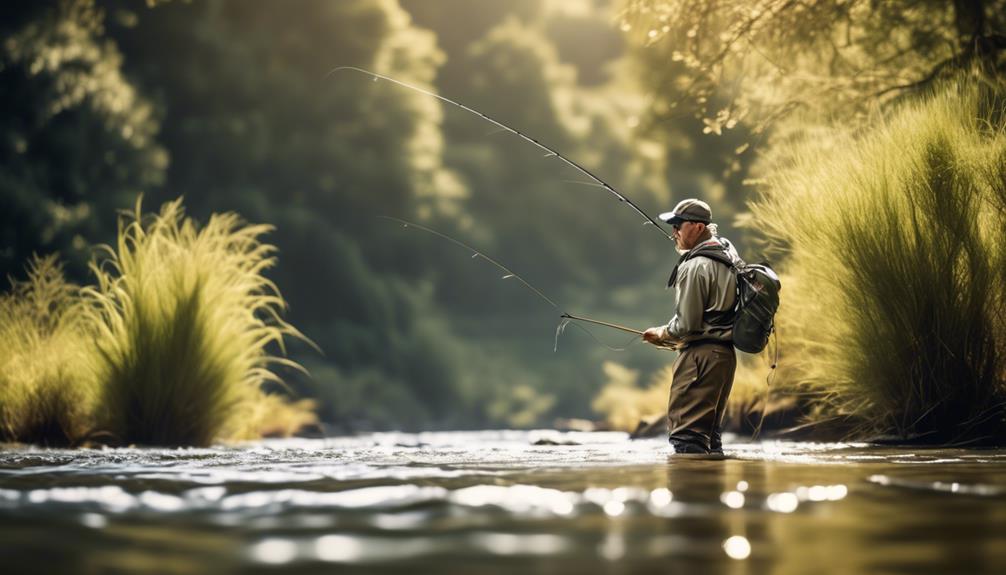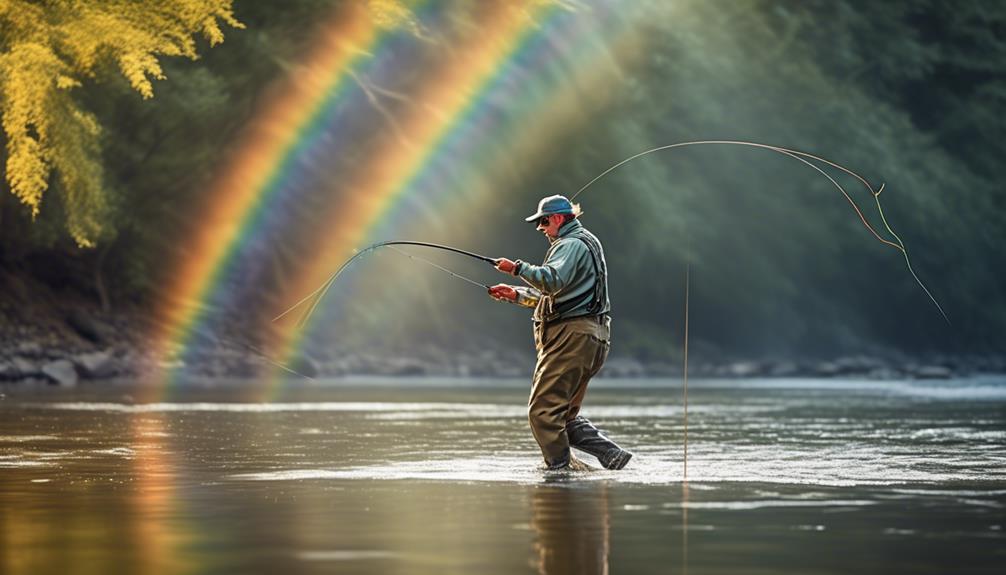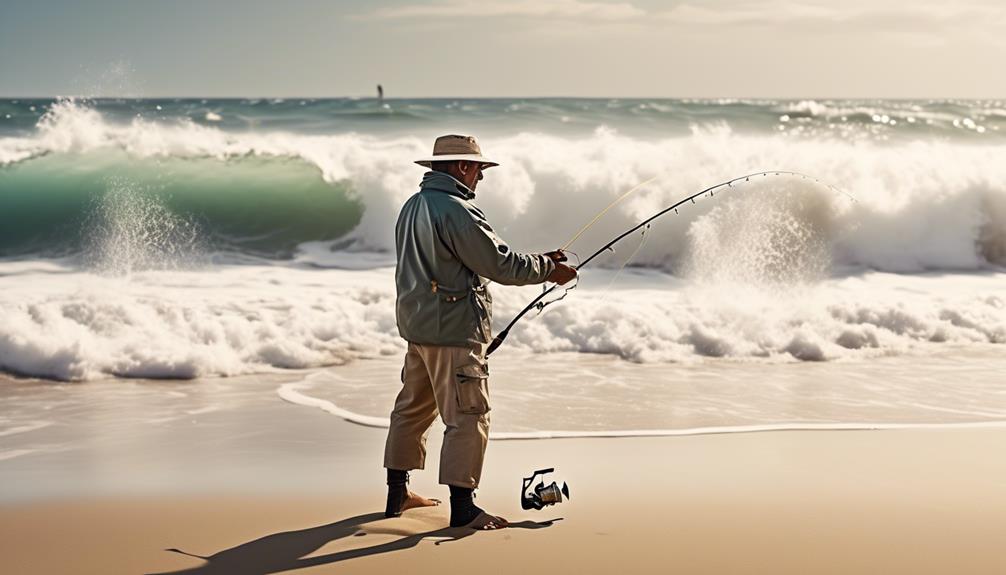Imagine this: it's a warm summer day, and you're standing knee-deep in a crystal-clear river, surrounded by the serene beauty of nature. You cast your line into the water, and suddenly, a vibrant rainbow trout leaps out, glistening in the sunlight.
Now, you're eager to learn the most effective techniques for fly fishing rainbow trout. As you continue reading, you'll discover key strategies that will help you not only hook these elusive fish but also successfully reel them in.
So, let's dive in and explore the fascinating world of fly fishing for rainbow trout.
Equipment Selection
Selecting the appropriate gear is crucial for effectively targeting rainbow trout when fly fishing. Your fly rod should be lightweight and flexible, typically around 8 to 9 feet long to provide the necessary leverage and control. Pair this with a weight-forward floating line, which is versatile and easy to cast, making it ideal for various fishing conditions. When it comes to reels, a simple click-and-pawl reel is often sufficient for rainbow trout, but ensure that it's balanced with your rod for smooth casting and retrieval.
Your choice of leader and tippet is equally important. Opt for a leader that's around 9 feet in length, tapering down to a 5x or 6x tippet. This setup allows for delicate presentations and the necessary finesse to entice rainbow trout. As for flies, patterns such as the Elk Hair Caddis, Adams, and Woolly Bugger are reliable go-tos. Carry a selection of sizes and variations to adapt to the trout's preferences and the prevailing conditions.
Don't overlook your clothing and accessories. A quality pair of polarized sunglasses can make spotting trout and minimizing glare on the water much easier. Additionally, investing in a good pair of waders and wading boots will enhance your mobility and comfort when navigating the river or stream.
Proper Fly Presentation
When targeting rainbow trout, your success in proper fly presentation hinges on mastering the art of delicately presenting your fly to entice the trout, building upon your equipment selection to maximize your chances of a successful catch. To ensure an effective fly presentation, consider the following techniques:
- Approach and Positioning
- Sneak Up: Approach the area where the trout are without making too much noise or causing disturbance in the water. Position yourself in a spot that allows for a clear and accurate cast towards the trout.
- Downstream Drift: When presenting your fly, opt for a downstream drift to mimic the natural flow of food in the water, making it more enticing for the trout to strike.
- Undercut Banks and Overhangs: Cast your fly under undercut banks or overhanging vegetation where trout are likely to be hiding. This presentation technique mimics the natural movement of insects falling into the water from above.
Mastering proper fly presentation involves understanding the behavior of the rainbow trout and using techniques that closely mimic the movement of their natural prey.
Reading Water

Consider observing the water's surface patterns and movements to identify potential trout holding areas. When reading the water, look for places where the current slows down, such as behind rocks, along the edges of riffles, or near submerged logs and vegetation. These areas provide shelter and a break from the current, making them ideal spots for rainbow trout to hold and feed.
One key aspect of reading water is understanding how different water features affect trout behavior. For instance, riffles and runs create oxygen-rich environments, attracting trout in search of food. Additionally, deep pools offer refuge and protection, especially during warmer weather when trout seek cooler temperatures. By recognizing these water features, you can pinpoint where the trout are likely to be and adjust your fly presentation accordingly.
Another crucial element of reading water is paying attention to surface activity. Observe for rising fish, which indicate actively feeding trout. This behavior often occurs when insects hatch, providing an opportunity to match the hatch with your fly selection. Similarly, pay attention to the movement of aquatic insects or baitfish, as trout will position themselves strategically to intercept their prey.
Furthermore, understanding the speed and depth of the water is essential for successful fly fishing. Slower water requires a more delicate presentation, while faster currents may necessitate a drag-free drift. By reading the water and adapting your approach accordingly, you can increase your chances of effectively targeting rainbow trout in diverse river and stream environments.
Understanding Hatch Cycles
To identify when rainbow trout are likely to be actively feeding, it's important to understand the various hatch cycles that occur in the aquatic environment. Hatch cycles refer to the life stages of aquatic insects, such as mayflies, caddisflies, and stoneflies, which are essential food sources for rainbow trout. By familiarizing yourself with these hatch cycles, you can better predict when the trout will be feeding and select the most effective fly patterns to use.
- Mayflies: Mayflies have a unique life cycle consisting of egg, nymph, dun, and spinner stages. Understanding the timing of these stages can help you anticipate when the trout will be feeding on mayflies.
- *Nymph Stage*: Nymphs are typically found in the water for an extended period before emerging as adults. Pay attention to the emergence patterns to know when the trout will be feeding on nymphs.
- *Dun Stage*: Duns are the newly emerged adults and are often found on the water's surface. Trout can be observed feeding on these insects during this stage.
- Caddisflies: Caddisflies also go through egg, larva, pupa, and adult stages. Observing the emergence of caddisflies can give you insights into when the trout will be actively feeding.
- *Pupa Stage*: Pupae are highly active as they prepare to emerge as adults, making them a prime target for feeding trout.
- Stoneflies: Stoneflies have a life cycle similar to mayflies and caddisflies, with eggs, nymphs, and adults. Understanding the emergence patterns of stoneflies can help you anticipate when the trout will be feeding on them.
Nymphing Techniques

Surefire nymphing techniques can significantly improve your success in catching rainbow trout. When nymphing for rainbow trout, it's crucial to understand the behavior of these fish. Rainbow trout tend to feed near the bottom of the river or stream, making nymphing an effective method.
To increase your chances of a successful catch, try using the 'dead drift' technique. This involves casting your nymph upstream and allowing it to drift naturally with the current. This mimics the natural movement of nymphs in the water and can attract hungry rainbow trout.
Another effective nymphing technique is the 'indicator nymphing' method. This involves using a small, buoyant indicator attached to your line to detect strikes. By adjusting the depth of your nymph based on the water's depth and current speed, you can effectively present your nymph at the trout's feeding level. Additionally, using weighted nymphs can help get your fly down to where the trout are feeding. Be sure to vary your retrieve to find the most effective presentation, as rainbow trout can be selective about the movement of their prey.
When nymphing for rainbow trout, it's essential to pay attention to the water's temperature and the time of day. Rainbow trout tend to be more active in cooler water and during low light conditions, so adjusting your nymphing techniques accordingly can greatly improve your chances of a successful catch.
Dry Fly Strategies
After mastering nymphing techniques for rainbow trout, you can now explore effective dry fly strategies to further enhance your fly fishing success. Dry fly fishing is an exhilarating method that involves presenting the fly on the water's surface to imitate an insect landing or hatching.
To successfully employ dry fly strategies for rainbow trout, consider the following techniques:
- Matching the Hatch: Observing the insects in the area and selecting a dry fly pattern that closely resembles the insects present will significantly increase your chances of enticing rainbow trout. Understanding the size, color, and behavior of the insects can help you select the most appropriate dry fly pattern.
- Presentation: Pay close attention to your presentation. Ensure that your fly lands gently on the water's surface and drifts naturally with the current. Mimicking the natural movement of an insect will attract the attention of rainbow trout.
- Reading the Water: Understanding the trout's behavior and the water conditions is crucial. Look for rising fish, feeding lanes, and areas with cover where rainbow trout are likely to be found. By reading the water, you can strategically position your dry fly for better success.
Streamer Tactics

When employing streamer tactics for rainbow trout, focus on precision and control in your presentation to effectively mimic the movement of baitfish. Choose streamer patterns that imitate the size and color of the local baitfish, such as sculpins, leeches, or minnows.
Start by casting across or slightly upstream, allowing the streamer to sink to the desired depth before beginning your retrieve. Vary your retrieve speed, incorporating pauses and erratic movements to imitate the natural behavior of fleeing prey. This erratic retrieve can trigger aggressive strikes from opportunistic rainbow trout.
When fishing streamers, it's crucial to pay attention to the depth at which the trout are holding. Adjust the sinking rate of your streamer or use sinking lines to reach the desired depth. By maintaining control and varying your retrieval depth, you can effectively target rainbow trout holding in different parts of the water column.
Additionally, consider the water conditions when selecting streamer tactics. In murky or high-flow waters, using larger, more visible streamer patterns can help grab the attention of rainbow trout. Conversely, in clear and slow-moving waters, opt for smaller, more natural-looking streamers to entice selective trout.
Frequently Asked Questions
How Can I Best Approach and Wade in a River to Avoid Spooking Rainbow Trout?
To best approach and wade in a river without spooking rainbow trout, move slowly and carefully. Avoid making sudden movements and wear muted or camouflaged clothing to blend in with the surroundings. Be mindful of your shadow.
What Are Some Effective Ways to Handle and Release Rainbow Trout to Ensure Their Survival?
When handling and releasing rainbow trout, gently hold them in the water, supporting their belly, and avoid touching their gills or eyes. Minimize air exposure, use barbless hooks, and release them quickly to ensure their survival.
Are There Any Specific Types of Aquatic Insects That Rainbow Trout Are Particularly Fond Of?
When fly fishing for rainbow trout, focus on aquatic insects like mayflies, caddisflies, and stoneflies. These insects are a particular favorite of rainbow trout and can be effectively imitated with various fly patterns to attract them.
What Are Some Common Mistakes That Beginners Make When Trying to Catch Rainbow Trout?
When trying to catch rainbow trout, beginners often make the mistake of using oversized or flashy lures, casting too aggressively, and not paying attention to the water currents. Stay patient, observe the environment, and adjust your approach.
Are There Any Special Regulations or Restrictions for Fishing Rainbow Trout in Certain Areas?
In certain areas, special regulations or restrictions may apply to fishing rainbow trout. It's essential to check local fishing regulations before heading out to ensure compliance and to help protect the trout population.
Conclusion
So, next time you're out on the water, remember to:
- choose the right equipment
- present your fly properly
- read the water
- understand hatch cycles
- use nymphing, dry fly, and streamer techniques
By mastering these effective techniques, you'll have a better chance of catching those beautiful rainbow trout.
Happy fishing!



